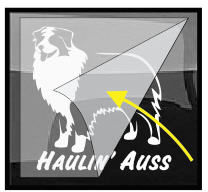NickerStickers Decals are Easy to Apply!Whether you've never, ever applied a decal before or are an old pro, NickerStickers go on smooth and easy and stick very well.
Before you start, WASH THE SURFACE!
Don't Use Window Cleaner!
We recommend you use plain old soap and water, 1/3 cup soap to 1 cup water. If there is any wax build up, use a scrubby. Finish with a lint free cloth to dry. You can add additional touch of extra cleaning with rubbing alcohol, mixed half and half with water. But soap and water is usually good enough.
Step 1. Peel the transfer tape with the decal stuck to it away from the waxy backing paper. The adhesive side of your decal is now exposed. Be careful! Don't get it dirty and don't touch it with your fingers. Use the clear transfer tape to hold because you'll be taking that off later anyway.

Step 2. Using the transfer tape, roll your decal on to the surface to which you are applying, starting at one corner and laying it down. Once it is on the surface, rub on top of the clear transfer tape and decal using a credit card and working from the center out. Press lightly at first, then repeat more firmly. Repeat several times.

Step 3. REMOVE THE TRANSFER TAPE. The decal is under the transfer tape. Pull the transfer tape up at a sharp angle beginning at one corner. Remove the clear tape on top of the decal and throw it away. Your decal should easily stick to the surface while you are pulling up the transfer tape. If it's not sticking solid, try leaving it on overnight and taking it off the next day.

For more information on decal application, including applying large decals,
video instruction, and trouble shooting, click here:

The St. Bernard, also called Alpine Mountain Dogs or Alpine
Cattle Dogs, are the large farm dogs of the farmers and dairymen of
most notably the French Alps, livestock guardians, herding dogs, and draft
dogs as well as hunting dogs, search and rescue dogs, and watchdogs.
These dogs are thought to be descendants of molosser type dogs
brought into the Alps by the ancient Romans, and the St. Bernard is recognized
internationally today as one of the Molossoid breeds.
The name "St. Bernard" originates from the passes
of Great and Little St Bernard. The two traveler's hospices and
passes are located only few miles away in the Western Alps between Switzerland Italy and France,
near the Mont-Blanc. The passes, the lodges, and the dogs are named
for Bernard of Menthon, the 11th century monk who established
the stations.
St. Bernard dogs are no longer used for Alpine rescues, the
last recorded instance of which was in 1955. As late as 2004, the Great St
Bernard Hospice still retained 18 of the dogs for reasons of tradition and
sentiment. In that year the Barry Foundation created breeding kennels for the
breed at the town of Martigny down the Great Saint Bernard Pass, and purchased
the remaining dogs from the Hospice. During the summer months each year a
number of the animals are temporarily relocated from Martigny to the Hospice
for viewing by tourists.
An annual celebration of the breed takes place on the Little
Saint Bernard Pass and at the town of Rosières-Montvalzan on the
French side. Saint Bernard dog enthusiasts and breeders gather for a dog show
and parades.[
The animals bred by the Foundation are trained to
participate in a variety of dog sports including carting and weight
pulling. The dogs at the Barry Foundation are reportedly smaller than the
average St Bernard.